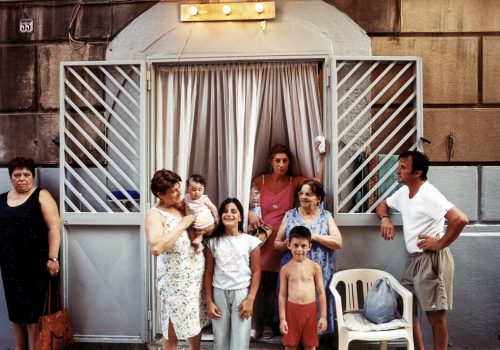Four different photographic projects that inevitably intertwined with the photographer’s own life. Developed over fifteen years, narrating the story of a struggling Italy, with no illusions, in a constant state of fluctuation between living up to stereotype and melancholy postcard.
Emiliano Mancuso uses various techniques and languages: black and white, color, digital and analog images. Even Polaroids – Important because they capture the moment instantly and accompany the photographer from one shot to the next, In motion. Without ever abandoning his primary media of Investigation, if anything broadening it with audio and video, Emiliano Mancuso portrays a country interwoven with micro stories; life experiences that lay bare their honesty.
In 2008 Emiliano left for his first of many trips to Southern Italy.
The journeys were brief and he took simple snapshots. Complete awareness hadn’t surfaced yet, but from the very first photographs, his had the extraordinary capacity to relate to others, whoever they may be; often casual encounters, sometimes marginal.
Mancuso approached them, entered their lives, became a part of it. A natural empathy marked his vision and softened it: always unprejudiced, never judgmental. In Terre di Sud (Southlands), the first chapter in this epic, we feel his sensitivity, the emotional intensity that allowed him to accept and be accepted. His work portrays humanist photography, intimate, spontaneous and complicit, in the noblest sense.
Terre di Sud was a long-term project that continued until 2008. The photography book that collects part of the pictures was turned into an exhibition and the writer, Domenico Starnone, wrote the preface.
The year 2008 was the same year In which Emiliano Mancuso felt the need to begin a new chapter, this time on all of Italy. He wrote, “From the end of 2008 and the early days of 2009, Italian media officially declared that Italy was entering a “crisis”, the economy was weakening under the pressure of the global crisis, the shadow of poverty was becoming an argument for debate in addition to issues on Immigration and safety.”
He followed an itinerary in a camper with four journalists, and Stato d’Italia (The State of Italy) was created. “I decided to go on the road and begin a photographic project on Italy in recent years. A Journey from north to south that hopes to gather together the outskirts of Rome and Milan, migrant landings in Lampedusa and the events in Rosarno, the industrial crisis in Sardinia and moments of everyday life: weddings, unemployment, poverty, and local nightclubs. This project Is my reflection on Italy, the reflection of a photographer or, if you like, a citizen that is always taken by surprise by the current state of Italy.”
The result Is a portrait in black and white, powerful and passionate. lt became a book, and later an exhibition, Stato d’Italia, with a preface by Lucia Annunziata and contributions from the journalists that journeyed with him: Angela Mauro, Andrea Milluzzi, Laura Eduati and Davide Vari. The project traveled around Italian piazzas, was shown at festivals and became a point of reference for photojournalism. The weekly publication L’Espresso published excerpts from it.
It was the last chapter in Emiliano Mancuso’s Journey that used only photographs. The projects that followed: Il diario di Felix (The Felix Diaries) – a profound portrait of a community of adolescents in a group home – and Le Cicale (The Cicadas) – the problems of aging seen through the lives of four individual stories – are documentary films in which the photographer never gives up photographs completely, but focuses more on audio and video. the documentaries were well recelved at documentary film festivals and would later be screened in independent movie theaters.
A Different Kind of Beauty, Italy 2003-2018, is a single exhibition of all the photographic works by Mancuso: Terre di Sud, Stato d’Italia, Il diario di Felix and Le Cicale, connected by the critical issues in Italy and joined together by the compassion of its protagonists. The exhibition Includes the screening of the documentaries Il diario di Felix and Le Cicale in addition to a video montage created by Emiliano Mancuso during his trips: clips, fragments, interviews and monologues.
There is a disarming naivete and at the same time a solid conviction in Emiliano Mancuso’s works.
We feel his empathy in his portrayal of the people he has chosen to talk about Italy.
Politics, economics, and micro stories are always filtered by individual tales. First-hand experiences and testimonies. With candor and fearless daring, we witness the passing of our times told with rare compassion.
Renata Ferri
















